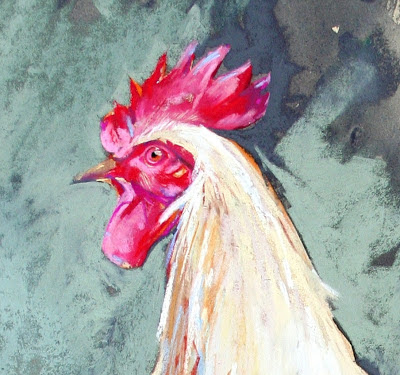I demonstrated pastels to the lovely Crowborough Art Group yesterday and this is the result. I have to say that I couldn't resist tinkering with it a bit at home, adjusting the tail feathers and working on the background.
I used my favourite Fisher 400 paper to convey just how flexible pastels can be; scraping in details, adding water to the surface and layering colour. I use Unison pastels in the main. I love the balance of fine pigment and find that they are fairly robust. I do love Sennelier too, but although the buttery softness is very seductive, I do look back at what is in my hand and find most of it has turned to dust. I reserve these for blending on a softer surface. I do add a little conte pastel just here and there when a bold narrow line is required (around the bird's eye for example).
Note the detail in the cockerel's eye. Here I used conte pencils in pinks, red, burnt sienna and a dot of black for his pupil. I used a shard of white Unison for the highlight.
Scraping
I do find the best way to achieve a sharp, thin line is to use some sort of tool to scrap away pastel. Anything will do, a stick, the end of a brush, a feather, an unfurled paperclip ... even my broken off piece of aerial. Do not use anything too sharp though, scalpels for example may cut the paper, certainly you and could break off under pressure.
This technique often needs a little planning. Look carefully at the subject and decide on the colour required for the line. Apply this colour to the Fisher 400 and rub in well. Next work over with the surrounding colour and scrape away. see the tail feathers below.
.jpg)

.jpg)
.jpg)
.jpg)
.JPG)
.JPG)

